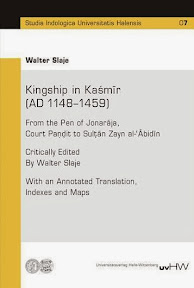Kingship in Kaśmīr (AD 1148–1459)
Slaje, Walter:
Kingship in Kaśmīr (AD 1148–1459) : from the Pen of Jonarāja, Court Paṇḍit to Sulṭān Zayn al-‛Ābidīn / critically ed. by Walter Slaje. With an Annotated Translation, Indexes and Maps. - Halle (Saale) : Universitätsverlag Halle-Wittenberg, 2014. - 330 S. : Ill., Kt. - (Studia Indologica Universitatis Halensis ; 7)
ISBN 978-3-86977-088-8
EUR 78,00
DDC 954.602
Beschreibung
Commissioned by Sulṭān Zayn al-‘Ābidīn to carry on Kalhaṇa’s Rājataraṅgiṇī, Paṇḍit Jonarāja was the first to compose another Rājataraṅgiṇī in continuation. Jonarāja’s work covers the period of Hindu rule in Kaśmīr from AD 1148 until its decline in AD 1339 (Koṭā Devī) and the transition to Islamic sovereignty exercised by the Šāh Mīr dynasty. His account, couched in poetical language, breaks off in AD 1459, the year of his death. The latter half of Jonarāja’s chronicle focuses on the three Sulṭāns of Kaśmīr, Sikandar Šāh and his sons ‘Alī Šāh and Zayn al-‘Ābidīn, whose lives he had recorded for the most part as an eyewitness. The causes and circumstances accompanying the Islamization of the valley from AD 1339 onward are accordingly depicted in a comparatively detailed manner. The present critical edition of Jonarāja was prepared mainly from Śāradā manuscripts, which have only recently emerged, and from the pool of variant readings reported by Srikanth Kaul (1967). It comprises all additional and substitutional stanzas of Pseudo-Jonarāja and is accompanied by an annotated translation that also includes a rendering of Pseudo-Jonarāja’s text, translated here for the first time.The book comes with a Rājataraṅgiṇī research bibliography, comprehensive indexes of contemporary personal names and toponyms along with their geographic coordinates. An image of Sulṭān Zayn’s founding stone of his artificial island (Laṅkā) in the Volur Lake and four maps with historical sites of central importance to events and personalities as portrayed by Jonarāja conclude the volume. [Verlagsinformation]
Inhalt
Preface. 5
Rājataraṅgiṇī Research Bibliography and Quoted Literature. 9
Introduction. 27
1. Jonarāja. 28
2. The Character of Jonarāja’s Rājataraṅgiṇī. 30
3. The Text of Jonarāja’s Rājataraṅgiṇī. 37
3.1 Sigla. 37
3.2 Strands of Transmission. 42
4. Conventions and Editorial Principles. 47
4.1 Abbreviations used in the Critical Apparatus. 47
4.2 Symbols used in the Critical Apparatus. 48
4.3 Orthography. 48
4.4 Names. 49
4.5 Translation. 50
5. Contents in Chronological Order of Rulers. 52
The Rājataraṅgiṇīs of Jonarāja and Pseudo-Jonarāja. 53
Sanskrit Text and English Translation. 53
Notes on the Translation. 256
Indexes. 293
Names and Terms. 293
Toponymical Index. 311
Plate and Maps of Historical Sites
Herausgeber
WALTER SLAJE, Professor für Indologie an der Universität Halle-Wittenberg. Mitarbeiterseite. Wikipedia [de].
Quellen: Universitätsverlag Halle-Wittenberg; Deutsche Nationalbibliothek; Buchhandel.de; Bookbutler
Bildquelle: Universitätsverlag Halle-Wittenberg
Bibliographie: [1]
References
- (2014). Kingship in Kaśmīr (AD 1148–1459): from the Pen of Jonarāja, Court Paṇḍit to Sulṭān Zayn al-‛Ābidīn. Studia Indologica Universitatis Halensis; 7. 330 S.
Ähnlich
- Llewellyn-Jones: Last King in India
- After Timur Left
- Fischer-Tiné: Shyamji Krishnavarma
- Biedermann: The Portuguese in Sri Lanka and South India
- Cederlöf: Founding an Empire on India's North-Eastern Frontiers
- Francis: Le discours royal dans l'Inde du Sud ancienne 1
- Horstmann: Jaipur 1778
- Avelar: História de Goa
- Paranjape: Making India
- Kumarasingham: A Political Legacy of the British Empire

